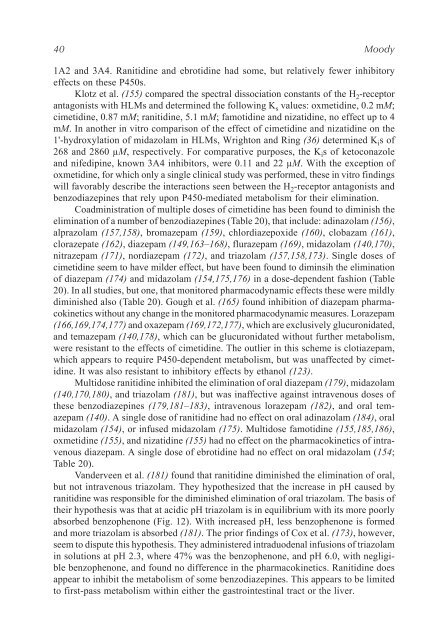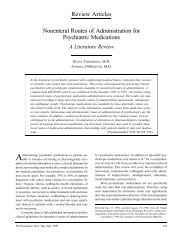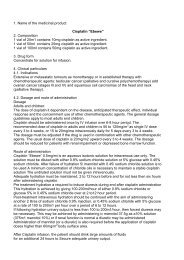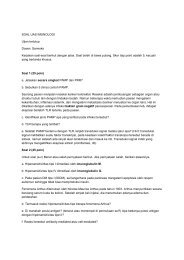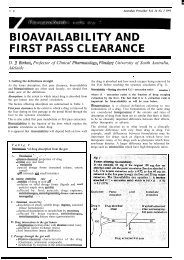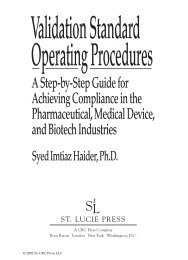- Page 1 and 2: Handbook of Drug Interactions A A C
- Page 3 and 4: F O R E N S I C SCIENCE AND MEDICIN
- Page 5 and 6: © 2004 Humana Press Inc. 999 River
- Page 7 and 8: vi Preface effects at the level of
- Page 9 and 10: viii Contents Chapter 9: Drug Inter
- Page 11 and 12: x Contributors NATHAN L. KANOUS II,
- Page 13 and 14: 1. Drug Interactions with Benzodiaz
- Page 15 and 16: 1. Drug Interactions with Benzodiaz
- Page 17 and 18: 1. Drug Interactions with Benzodiaz
- Page 19 and 20: 1. Drug Interactions with Benzodiaz
- Page 21 and 22: 1. Drug Interactions with Benzodiaz
- Page 23 and 24: 1. Drug Interactions with Benzodiaz
- Page 25 and 26: 1. Drug Interactions with Benzodiaz
- Page 27 and 28: 1. Drug Interactions with Benzodiaz
- Page 29 and 30: 1. Drug Interactions with Benzodiaz
- Page 31 and 32: 1. Drug Interactions with Benzodiaz
- Page 33 and 34: 1. Drug Interactions with Benzodiaz
- Page 35 and 36: 1. Drug Interactions with Benzodiaz
- Page 37 and 38: 1. Drug Interactions with Benzodiaz
- Page 39 and 40: 1. Drug Interactions with Benzodiaz
- Page 41 and 42: 1. Drug Interactions with Benzodiaz
- Page 43 and 44: 1. Drug Interactions with Benzodiaz
- Page 45 and 46: 1. Drug Interactions with Benzodiaz
- Page 47 and 48: 1. Drug Interactions with Benzodiaz
- Page 49: 1. Drug Interactions with Benzodiaz
- Page 53 and 54: 1. Drug Interactions with Benzodiaz
- Page 55 and 56: 1. Drug Interactions with Benzodiaz
- Page 57 and 58: 1. Drug Interactions with Benzodiaz
- Page 59 and 60: 1. Drug Interactions with Benzodiaz
- Page 61 and 62: 1. Drug Interactions with Benzodiaz
- Page 63 and 64: 1. Drug Interactions with Benzodiaz
- Page 65 and 66: 1. Drug Interactions with Benzodiaz
- Page 67 and 68: 1. Drug Interactions with Benzodiaz
- Page 69 and 70: 1. Drug Interactions with Benzodiaz
- Page 71 and 72: 1. Drug Interactions with Benzodiaz
- Page 73 and 74: 1. Drug Interactions with Benzodiaz
- Page 75 and 76: 1. Drug Interactions with Benzodiaz
- Page 77 and 78: 1. Drug Interactions with Benzodiaz
- Page 79 and 80: 1. Drug Interactions with Benzodiaz
- Page 81 and 82: 1. Drug Interactions with Benzodiaz
- Page 83 and 84: 1. Drug Interactions with Benzodiaz
- Page 85 and 86: 1. Drug Interactions with Benzodiaz
- Page 87 and 88: 1. Drug Interactions with Benzodiaz
- Page 89 and 90: 1. Drug Interactions with Benzodiaz
- Page 91 and 92: 1. Drug Interactions with Benzodiaz
- Page 93 and 94: 1. Drug Interactions with Benzodiaz
- Page 95 and 96: 1. Drug Interactions with Benzodiaz
- Page 97 and 98: 1. Drug Interactions with Benzodiaz
- Page 99 and 100: 2. Antiepileptic Drugs 89 Chapter 2
- Page 101 and 102:
2. Antiepileptic Drugs 91 cle consi
- Page 103 and 104:
2. Antiepileptic Drugs 93 increases
- Page 105 and 106:
2. Antiepileptic Drugs 95 Table 1 (
- Page 107 and 108:
Table 3 Interactions with Other Dru
- Page 109 and 110:
2. Antiepileptic Drugs 99 2.2.3.2.
- Page 111 and 112:
2. Antiepileptic Drugs 101 Ca + flu
- Page 113 and 114:
2. Antiepileptic Drugs 103 2.4.3.1.
- Page 115 and 116:
2. Antiepileptic Drugs 105 soluble
- Page 117 and 118:
2. Antiepileptic Drugs 107 Oral bio
- Page 119 and 120:
2. Antiepileptic Drugs 109 Side eff
- Page 121 and 122:
2. Antiepileptic Drugs 111 whereas
- Page 123 and 124:
2. Antiepileptic Drugs 113 tions de
- Page 125 and 126:
2. Antiepileptic Drugs 115 peripher
- Page 127 and 128:
2. Antiepileptic Drugs 117 2.12.4.
- Page 129 and 130:
2. Antiepileptic Drugs 119 19. Spie
- Page 131 and 132:
2. Antiepileptic Drugs 121 66. McLe
- Page 133 and 134:
3. Opioids and Opiates 123 Chapter
- Page 135 and 136:
3. Opioids and Opiates 125 Because
- Page 137 and 138:
3. Opioids and Opiates 127 at very
- Page 139 and 140:
3. Opioids and Opiates 129 uted to
- Page 141 and 142:
3. Opioids and Opiates 131 fear tha
- Page 143 and 144:
3. Opioids and Opiates 133 Situatio
- Page 145 and 146:
3. Opioids and Opiates 135 gests th
- Page 147 and 148:
3. Opioids and Opiates 137 fluvoxam
- Page 149 and 150:
3. Opioids and Opiates 139 Accordin
- Page 151 and 152:
3. Opioids and Opiates 141 Table 4
- Page 153 and 154:
3. Opioids and Opiates 143 As with
- Page 155 and 156:
3. Opioids and Opiates 145 35. Kapl
- Page 157 and 158:
3. Opioids and Opiates 147 78. Dund
- Page 159 and 160:
4. MAOIs and Tricyclic Antidepressa
- Page 161 and 162:
4. MAOIs and Tricyclic Antidepressa
- Page 163 and 164:
4. MAOIs and Tricyclic Antidepressa
- Page 165 and 166:
4. MAOIs and Tricyclic Antidepressa
- Page 167 and 168:
4. MAOIs and Tricyclic Antidepressa
- Page 169 and 170:
4. MAOIs and Tricyclic Antidepressa
- Page 171 and 172:
4. MAOIs and Tricyclic Antidepressa
- Page 173 and 174:
4. MAOIs and Tricyclic Antidepressa
- Page 175 and 176:
4. MAOIs and Tricyclic Antidepressa
- Page 177 and 178:
4. MAOIs and Tricyclic Antidepressa
- Page 179 and 180:
4. MAOIs and Tricyclic Antidepressa
- Page 181 and 182:
4. MAOIs and Tricyclic Antidepressa
- Page 183 and 184:
4. MAOIs and Tricyclic Antidepressa
- Page 185 and 186:
176 Mozayani and Mozayani Table 1 P
- Page 187 and 188:
178 Mozayani and Mozayani Table 3 M
- Page 189 and 190:
180 Mozayani and Mozayani Table 4 D
- Page 191 and 192:
182 Mozayani and Mozayani 8. Fichte
- Page 193 and 194:
184 Mozayani and Mozayani 50. Presk
- Page 195 and 196:
6. Antipsychotic Drugs and Interact
- Page 197 and 198:
6. Antipsychotic Drugs and Interact
- Page 199 and 200:
6. Antipsychotic Drugs and Interact
- Page 201 and 202:
6. Antipsychotic Drugs and Interact
- Page 203 and 204:
6. Antipsychotic Drugs and Interact
- Page 205 and 206:
198 Welner Stage three, orgasm, is
- Page 207 and 208:
200 Welner Table 3 Antipsychotics a
- Page 209 and 210:
202 Welner Table 4 Antipsychotics a
- Page 211 and 212:
204 Welner the distinctions noted i
- Page 213 and 214:
206 Welner Competency to be execute
- Page 215 and 216:
208 Welner 7.1. New Frontiers of Ac
- Page 217 and 218:
210 Welner causing seizures (114),
- Page 219 and 220:
212 Welner 36. Ghadirian AM, Annabl
- Page 221 and 222:
214 Welner 86. Kaplan H and Sadock
- Page 223 and 224:
7. Cardiovascular Drugs 217 PART II
- Page 225 and 226:
220 Auer Fig. 1. Action potential a
- Page 227 and 228:
222 Auer anemia, and rarely, anaphy
- Page 229 and 230:
224 Auer 1.2.6. Flecainide (Class I
- Page 231 and 232:
226 Auer low cardiac output. Import
- Page 233 and 234:
228 Auer Procainamide and N-acetylp
- Page 235 and 236:
230 Auer The centrally acting sympa
- Page 237 and 238:
232 Auer 2.2.3. Warnings 2.2.3.1. S
- Page 239 and 240:
234 Auer Table 2 Beta-Blockers: Ove
- Page 241 and 242:
236 Auer and Mb. Raynaud, because u
- Page 243 and 244:
238 Auer the metabolism of proprano
- Page 245 and 246:
240 Auer typically occurs when stro
- Page 247 and 248:
242 Auer Calcium channel blockers h
- Page 249 and 250:
244 Auer 3.3.3.4. NISOLDIPINE (56,5
- Page 251 and 252:
246 Auer edema194. A cough, althoug
- Page 253 and 254:
248 Auer 3.4.1.1.5. Angioneurotic E
- Page 255 and 256:
250 Auer receptor stimulation; and
- Page 257 and 258:
252 Auer Supraventricular Arrhythmi
- Page 259 and 260:
254 Auer and to measure a serum dig
- Page 261 and 262:
256 Auer A proximal left anterior d
- Page 263 and 264:
258 Auer Nitrates are contraindicat
- Page 265 and 266:
260 Auer 3. Potassium-sparing diure
- Page 267 and 268:
262 Auer mends breast-feeding be av
- Page 269 and 270:
264 Auer Hypochloremic alkalosis ca
- Page 271 and 272:
266 Auer Ototoxicity: Loop diuretic
- Page 273 and 274:
268 Auer the risk increases substan
- Page 275 and 276:
270 Auer risk of bleeding. Though t
- Page 277 and 278:
272 Auer there would predictably be
- Page 279 and 280:
274 Auer One limitation to the use
- Page 281 and 282:
276 Auer to mechanism of action and
- Page 283 and 284:
278 Auer 8.1.2.2. BILE ACID SEQUEST
- Page 285 and 286:
280 Auer lipase hydrolyzes triglyce
- Page 287 and 288:
282 Auer effect, however, has not b
- Page 289 and 290:
284 Auer include headache and occas
- Page 291 and 292:
286 Auer 11. Kasiske BL, Ma JZ, Kal
- Page 293 and 294:
288 Auer 55. Muck W, Wingender W, S
- Page 295 and 296:
290 Auer 93. Kaplan K, Divison R, P
- Page 297 and 298:
292 Auer 137. Bakker-Arkema RG, Dav
- Page 299 and 300:
8. Antimicrobial Drugs 295 Chapter
- Page 301 and 302:
8. Antimicrobial Drugs 297 ratories
- Page 303 and 304:
8. Antimicrobial Drugs 299 matic. L
- Page 305 and 306:
8. Antimicrobial Drugs 301 1.10. Tu
- Page 307 and 308:
8. Antimicrobial Drugs 303 3.1. Hos
- Page 309 and 310:
8. Antimicrobial Drugs 305 reaches
- Page 311 and 312:
8. Antimicrobial Drugs 307 Table 2
- Page 313 and 314:
8. Antimicrobial Drugs 309 Other ma
- Page 315 and 316:
8. Antimicrobial Drugs 311 lized by
- Page 317 and 318:
8. Antimicrobial Drugs 313 therapeu
- Page 319 and 320:
8. Antimicrobial Drugs 315 44. Guen
- Page 321 and 322:
8. Antimicrobial Drugs 317 84. Anan
- Page 323 and 324:
9. HIV/AIDS Drugs 319 Chapter 9 Dru
- Page 325 and 326:
9. HIV/AIDS Drugs 321 Table 1 Recom
- Page 327 and 328:
9. HIV/AIDS Drugs 323 of each other
- Page 329 and 330:
9. HIV/AIDS Drugs 325 Table 2 (cont
- Page 331 and 332:
9. HIV/AIDS Drugs 327 Table 2 (cont
- Page 333 and 334:
9. HIV/AIDS Drugs 329 INTERNET RESO
- Page 335 and 336:
9. HIV/AIDS Drugs 331 35. Knupp CA,
- Page 337 and 338:
9. HIV/AIDS Drugs 333 67. Veldkamp
- Page 339 and 340:
10. Nonsteroidal Antiinflammtory Dr
- Page 341 and 342:
338 Abukhalaf et al. analgesics, an
- Page 343 and 344:
340 Abukhalaf et al. Fig. 1. Biosyn
- Page 345 and 346:
342 Abukhalaf et al. 1.5.1. On the
- Page 347 and 348:
344 Abukhalaf et al. Table 2 Half-L
- Page 349 and 350:
346 Abukhalaf et al. Table 3 Toxic
- Page 351 and 352:
348 Abukhalaf et al. h. Digoxin, me
- Page 353 and 354:
350 Abukhalaf et al. most other NSA
- Page 355 and 356:
352 Abukhalaf et al. For the relief
- Page 357 and 358:
354 Abukhalaf et al. the normal dos
- Page 359 and 360:
356 Abukhalaf et al. 1.7.3.3. FENOP
- Page 361 and 362:
358 Abukhalaf et al. as needed, up
- Page 363 and 364:
360 Abukhalaf et al. Table 4 Acetom
- Page 365 and 366:
362 Abukhalaf et al. b. Rifampin: I
- Page 367 and 368:
364 Abukhalaf et al. Methotrexate i
- Page 369 and 370:
366 Abukhalaf et al. 2.1.4.2. DRUG
- Page 371 and 372:
368 Abukhalaf et al. 2.4.2. Drug In
- Page 373 and 374:
370 Abukhalaf et al. 2.7.2.1. PREPA
- Page 375 and 376:
372 Abukhalaf et al. Fig. 2. Inhibi
- Page 377 and 378:
374 Abukhalaf et al. 3. Meade EA, S
- Page 379 and 380:
376 Abukhalaf et al. 45. Epstein WV
- Page 381 and 382:
11. Food and Drug Interactions 379
- Page 383 and 384:
11. Food and Drug Interactions 381
- Page 385 and 386:
11. Food and Drug Interactions 383
- Page 387 and 388:
11. Food and Drug Interactions 385
- Page 389 and 390:
11. Food and Drug Interactions 387
- Page 391 and 392:
11. Food and Drug Interactions 389
- Page 393 and 394:
11. Food and Drug Interactions 391
- Page 395 and 396:
11. Food and Drug Interactions 393
- Page 397 and 398:
396 Jones The concentration of alco
- Page 399 and 400:
398 Jones Table 1 Examples of Sites
- Page 401 and 402:
400 Jones Fig. 2. Example of a bloo
- Page 403 and 404:
402 Jones Fig. 4. Examples of inter
- Page 405 and 406:
404 Jones use of oral contraceptive
- Page 407 and 408:
406 Jones Table 2 Typical Pharmacok
- Page 409 and 410:
408 Jones Fig. 7. Metabolic interac
- Page 411 and 412:
410 Jones into trichloroethanol (17
- Page 413 and 414:
412 Jones Fig. 9. Concentration-tim
- Page 415 and 416:
414 Jones liver disease may show a
- Page 417 and 418:
416 Jones Fig. 11. Scheme for metab
- Page 419 and 420:
418 Jones Some recent studies of ga
- Page 421 and 422:
420 Jones Fig. 12. Effect of pretre
- Page 423 and 424:
422 Jones concern when this kind of
- Page 425 and 426:
424 Jones Table 4 Effect of Cimetid
- Page 427 and 428:
426 Jones Fig. 13. Schematic repres
- Page 429 and 430:
428 Jones Table 5 Number of Individ
- Page 431 and 432:
430 Jones Finally, the role of keto
- Page 433 and 434:
432 Jones Table 7 Concentrations of
- Page 435 and 436:
434 Jones furnishes an example of a
- Page 437 and 438:
436 Jones the patient. However, the
- Page 439 and 440:
438 Jones evaluation of the fructos
- Page 441 and 442:
440 Jones Table 9 Top 10 Drugs Iden
- Page 443 and 444:
442 Jones 13. Pentilla A, Karhunen
- Page 445 and 446:
444 Jones 64. Hrobjartsson A and Go
- Page 447 and 448:
446 Jones 108. Lucey MR, Hill E, Yo
- Page 449 and 450:
448 Jones 151. Fraser AD. Clinical
- Page 451 and 452:
450 Jones 194. Jerntorp P, Ohlin H,
- Page 453 and 454:
452 Jones 240. Lin JH, Chiba M, and
- Page 455 and 456:
454 Jones 281. Greiff JMC and Rowbo
- Page 457 and 458:
456 Jones 320. Lüddens H, Pritchet
- Page 459 and 460:
458 Jones 371. Mandelli M, Tognono
- Page 461 and 462:
460 Jones 418. Allan AN and Harris
- Page 463 and 464:
462 Jones 464. Pirmohamed M and Par
- Page 465 and 466:
464 Cone, Fant, and Henningfield Fi
- Page 467 and 468:
466 Cone, Fant, and Henningfield Ci
- Page 469 and 470:
468 Cone, Fant, and Henningfield to
- Page 471 and 472:
470 Cone, Fant, and Henningfield ri
- Page 473 and 474:
472 Cone, Fant, and Henningfield di
- Page 475 and 476:
474 Cone, Fant, and Henningfield 3.
- Page 477 and 478:
476 Cone, Fant, and Henningfield th
- Page 479 and 480:
478 Cone, Fant, and Henningfield 3.
- Page 481 and 482:
480 Cone, Fant, and Henningfield 3.
- Page 483 and 484:
482 Cone, Fant, and Henningfield ma
- Page 485 and 486:
484 Cone, Fant, and Henningfield Ta
- Page 487 and 488:
486 Cone, Fant, and Henningfield 24
- Page 489 and 490:
488 Cone, Fant, and Henningfield 68
- Page 491 and 492:
490 Cone, Fant, and Henningfield 11
- Page 493 and 494:
492 Cone, Fant, and Henningfield 15
- Page 495 and 496:
494 von Deutsch, Abukhalaf, and Soc
- Page 497 and 498:
496 von Deutsch, Abukhalaf, and Soc
- Page 499 and 500:
498 von Deutsch, Abukhalaf, and Soc
- Page 501 and 502:
500 von Deutsch, Abukhalaf, and Soc
- Page 503 and 504:
502 von Deutsch, Abukhalaf, and Soc
- Page 505 and 506:
504 von Deutsch, Abukhalaf, and Soc
- Page 507 and 508:
506 von Deutsch, Abukhalaf, and Soc
- Page 509 and 510:
508 von Deutsch, Abukhalaf, and Soc
- Page 511 and 512:
510 von Deutsch, Abukhalaf, and Soc
- Page 513 and 514:
512 von Deutsch, Abukhalaf, and Soc
- Page 515 and 516:
514 von Deutsch, Abukhalaf, and Soc
- Page 517 and 518:
516 von Deutsch, Abukhalaf, and Soc
- Page 519 and 520:
518 von Deutsch, Abukhalaf, and Soc
- Page 521 and 522:
Table 5 Major Metabolites of Select
- Page 523 and 524:
522 von Deutsch, Abukhalaf, and Soc
- Page 525 and 526:
524 von Deutsch, Abukhalaf, and Soc
- Page 527 and 528:
526 von Deutsch, Abukhalaf, and Soc
- Page 529 and 530:
528 von Deutsch, Abukhalaf, and Soc
- Page 531 and 532:
530 von Deutsch, Abukhalaf, and Soc
- Page 533 and 534:
532 von Deutsch, Abukhalaf, and Soc
- Page 535 and 536:
534 von Deutsch, Abukhalaf, and Soc
- Page 537 and 538:
536 von Deutsch, Abukhalaf, and Soc
- Page 539 and 540:
538 von Deutsch, Abukhalaf, and Soc
- Page 541 and 542:
540 von Deutsch, Abukhalaf, and Soc
- Page 543 and 544:
542 von Deutsch, Abukhalaf, and Soc
- Page 545 and 546:
544 von Deutsch, Abukhalaf, and Soc
- Page 547 and 548:
546 von Deutsch, Abukhalaf, and Soc
- Page 549 and 550:
548 von Deutsch, Abukhalaf, and Soc
- Page 551 and 552:
550 von Deutsch, Abukhalaf, and Soc
- Page 553 and 554:
552 von Deutsch, Abukhalaf, and Soc
- Page 555 and 556:
554 von Deutsch, Abukhalaf, and Soc
- Page 557 and 558:
556 von Deutsch, Abukhalaf, and Soc
- Page 559 and 560:
558 von Deutsch, Abukhalaf, and Soc
- Page 561 and 562:
560 von Deutsch, Abukhalaf, and Soc
- Page 563 and 564:
562 von Deutsch, Abukhalaf, and Soc
- Page 565 and 566:
564 von Deutsch, Abukhalaf, and Soc
- Page 567 and 568:
566 von Deutsch, Abukhalaf, and Soc
- Page 569 and 570:
568 von Deutsch, Abukhalaf, and Soc
- Page 571 and 572:
570 von Deutsch, Abukhalaf, and Soc
- Page 573 and 574:
572 von Deutsch, Abukhalaf, and Soc
- Page 575 and 576:
574 von Deutsch, Abukhalaf, and Soc
- Page 577 and 578:
576 von Deutsch, Abukhalaf, and Soc
- Page 579 and 580:
578 von Deutsch, Abukhalaf, and Soc
- Page 581 and 582:
580 von Deutsch, Abukhalaf, and Soc
- Page 583 and 584:
582 von Deutsch, Abukhalaf, and Soc
- Page 585 and 586:
584 von Deutsch, Abukhalaf, and Soc
- Page 587 and 588:
586 von Deutsch, Abukhalaf, and Soc
- Page 589 and 590:
588 von Deutsch, Abukhalaf, and Soc
- Page 591 and 592:
590 von Deutsch, Abukhalaf, and Soc
- Page 593 and 594:
592 von Deutsch, Abukhalaf, and Soc
- Page 595 and 596:
594 von Deutsch, Abukhalaf, and Soc
- Page 597 and 598:
596 von Deutsch, Abukhalaf, and Soc
- Page 599 and 600:
15. Drug Interaction Litigation 599
- Page 601 and 602:
15. Drug Interaction Litigation 601
- Page 603 and 604:
15. Drug Interaction Litigation 603
- Page 605 and 606:
15. Drug Interaction Litigation 605
- Page 607 and 608:
15. Drug Interaction Litigation 607
- Page 609 and 610:
15. Drug Interaction Litigation 609
- Page 611 and 612:
15. Drug Interaction Litigation 611
- Page 613 and 614:
15. Drug Interaction Litigation 613
- Page 615 and 616:
15. Drug Interaction Litigation 615
- Page 617 and 618:
15. Drug Interaction Litigation 617
- Page 619 and 620:
15. Drug Interaction Litigation 619
- Page 621 and 622:
15. Drug Interaction Litigation 621
- Page 623 and 624:
15. Drug Interaction Litigation 623
- Page 625 and 626:
15. Drug Interaction Litigation 625
- Page 627 and 628:
15. Drug Interaction Litigation 627
- Page 629 and 630:
15. Drug Interaction Litigation 629
- Page 631 and 632:
632 Welner heightened when plaintif
- Page 633 and 634:
634 Welner Table 1 Serotonergic Ant
- Page 635 and 636:
636 Welner In the current climate o
- Page 637 and 638:
638 Welner Other than the distincti
- Page 639 and 640:
640 Welner 6. GUIDELINES FOR ASSESS
- Page 641 and 642:
642 Welner of a medicine, show pron
- Page 643 and 644:
644 Welner 29. American Psychiatric
- Page 645 and 646:
Index 647 Index A Acamprosate, alco
- Page 647 and 648:
Index 649 angioneurotic edema, 248
- Page 649 and 650:
Index 651 C Caffeine, nicotine inte
- Page 651 and 652:
Index 653 Didanosine, drug interact
- Page 653 and 654:
Index 655 GHB, see γ-Hydroxybutyra
- Page 655 and 656:
Index 657 drug interactions, 572, 5
- Page 657 and 658:
Index 659 O OCs, see Oral contracep
- Page 659 and 660:
Index 661 Ritonavir, drug interacti
- Page 661 and 662:
Index 663 Tripelannamine, nicotine


